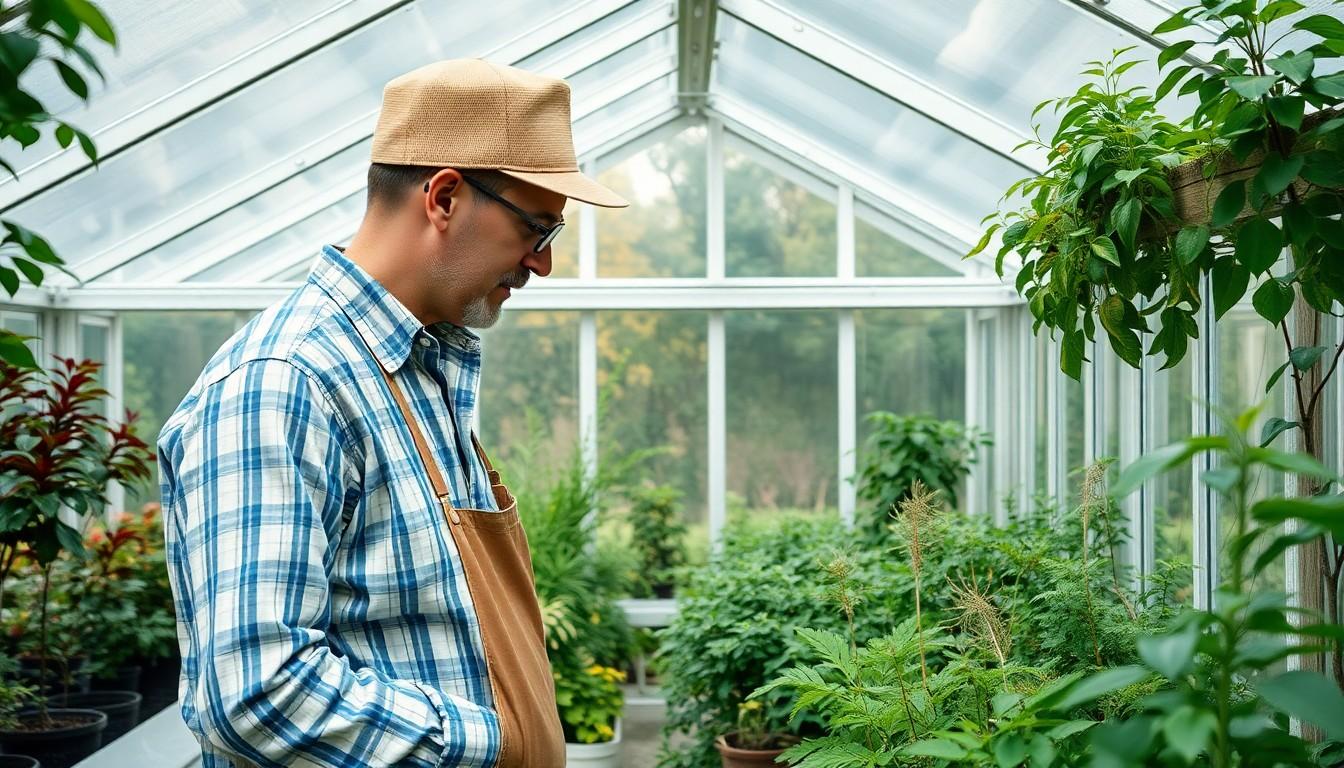
How to Choose Your First Greenhouse: A Complete Beginner’s Guide for 2025
Learn how to choose your perfect first greenhouse with our expert guide. Discover size, materials, and features to extend your growing season by 2-3 months.

Looking to protect your precious plants from nature’s fury? When it comes to greenhouse materials, durability matters more than you might think. Modern polycarbonate panels have revolutionised greenhouse construction with their exceptional strength and resilience.
These innovative panels aren’t just tough – they’re virtually unbreakable, boasting impact resistance up to 250 times stronger than traditional glass. With built-in UV protection and remarkable weather resistance, polycarbonate greenhouses stand firm against everything from harsh storms to scorching sun. You’ll enjoy peace of mind knowing your greenhouse can withstand hailstorms, falling debris and extreme temperature fluctuations while maintaining its clarity and structural integrity for years to come.
Polycarbonate greenhouse materials are made from advanced thermoplastic polymers that improve growing conditions. They’re durable and allow just the right amount of light for healthy plant growth.
Polycarbonate greenhouse panels consist of multiple layers connected by internal walls. The construction creates insulating air pockets between layers, delivering superior heat retention capabilities. This material’s key specifications include:
| Property | Measurement |
|---|---|
| Resistance to Impact | 200x stronger than glass |
| Light Permeability | 70-83% |
| Weight Ratio | 30x stronger than acrylic |
| UV Protection | Built-in coating |
The multiwall design maintains consistent internal temperatures by trapping warm air within the chambers. Each layer contributes to the overall structural integrity while providing enhanced insulation properties.
Polycarbonate greenhouse sheets come in three main variations:
Each sheet type offers specific benefits for different growing environments. Twin wall remains the most popular choice, balancing insulation with light transmission. Triple wall excels in colder climates where heat retention takes priority.

Polycarbonate greenhouse materials are highly durable and require little maintenance. Their impact resistance and thermal stability provide a long-lasting, stable environment for plants.
Polycarbonate panels demonstrate remarkable strength against physical impacts. The material is 200 times stronger than standard glass offering protection from:
The built-in UV protective layer in polycarbonate panels guards against harsh weather conditions:
Polycarbonate exhibits exceptional thermal stability across extreme temperature ranges:
| Temperature Range | Performance |
|---|---|
| Low Temperature | -40°C without cracking |
| High Temperature | 120°C without warping |
| Daily Fluctuation | ±50°C without damage |
The material retains its structural properties throughout seasonal temperature changes making it ideal for year-round greenhouse applications. The panels maintain their shape flexibility preventing brittleness in cold conditions sagging in heat.

Polycarbonate greenhouse materials provide significant environmental benefits through light control thermal efficiency. Here’s how these materials enhance growing conditions:
Polycarbonate panels allow 81-88% of light to pass through, providing excellent light transmission with clear sheets. This light transmission percentage creates bright interior spaces essential for plant growth requiring 6+ hours of daily sunlight. The materials include these specific features:
| Material Type | Light Transmission % |
|---|---|
| Clear Glass | 85-90 |
| Double Glass | 75-85 |
| Clear Polycarbonate | 85-88 |
| Clear Acrylic | 90-92 |
| Clear Styrene | 80-90 |
Polycarbonate’s thermal insulation properties create stable growing environments through:
The climate control features of polycarbonate panels enable year-round growing conditions:
The material’s thermal stability performs in temperature ranges from -40°C to 120°C without structural changes. This creates consistent growing conditions across seasons with minimal energy input requirements.

Polycarbonate greenhouse materials offer straightforward maintenance requirements for long-term performance. Regular care extends the lifespan of these durable structures with minimal effort.
Clean polycarbonate panels once or twice annually using mild soap water. Remove dirt buildup with a soft cloth or sponge to prevent scratching. Avoid abrasive cleaners like steel wool or harsh chemicals that damage the protective UV coating.
Key cleaning steps:
Polycarbonate panels resist degradation through built-in UV protection layers. Proper installation techniques prevent common issues:
Protection measures:
Polycarbonate greenhouse materials last 10-15 years with proper maintenance. The durability factors include:
| Feature | Specification |
|---|---|
| Impact Resistance | 200x stronger than glass |
| Temperature Range | -40°C to 120°C |
| UV Protection | Blocks 99% of rays |
| Wind Resistance | Up to 120 km/h |
| Light Transmission | 70-83% |

Polycarbonate and glass present distinct advantages for greenhouse construction based on durability, performance and cost factors. The choice between these materials impacts long-term maintenance requirements, growing conditions and overall value.
Polycarbonate demonstrates superior performance compared to glass in several key areas:
Glass offers these performance characteristics:
| Factor | Polycarbonate | Glass |
|---|---|---|
| Initial Cost | Higher upfront investment | Lower initial expense |
| Installation Cost | Lower due to lighter weight | Higher due to specialised handling |
| Maintenance Cost | Minimal cleaning twice yearly | Regular cleaning and repairs |
| Lifespan | 10-15 years | 20+ years with maintenance |
| Energy Efficiency | Higher insulation value | Lower insulation value |
Polycarbonate greenhouse materials are an excellent choice for your growing needs. Their exceptional durability, thermal properties, and UV protection create an efficient environment that lasts for over a decade.
Although the upfront cost may be higher than traditional materials, you’ll save on maintenance, enjoy better energy efficiency, and benefit from strong resistance to weather and impact. Your greenhouse will remain robust and clear, even in extreme temperatures and harsh conditions.
Choosing polycarbonate panels means investing in a long-lasting, high-performance solution that balances strength and longevity for your greenhouse project.
Polycarbonate panels are exceptionally strong, being 200 times more impact-resistant than glass. They can withstand severe weather conditions, including hailstorms, falling branches and high winds up to 120 km/h without breaking. Their durability makes them virtually unbreakable in normal greenhouse applications.
Polycarbonate panels demonstrate remarkable thermal stability, functioning effectively in temperatures from -40°C to 120°C without cracking or warping. This wide temperature range makes them suitable for year-round use in various climates whilst maintaining their structural integrity and flexibility.
Clear polycarbonate panels provide excellent light transmission rates between 81-88%, ideal for plants requiring over six hours of daily sunlight. The material also offers natural light diffusion to prevent hot spots and includes UV protection that blocks 99% of harmful radiation.
With proper maintenance, polycarbonate panels typically last 10-15 years. Their longevity is supported by built-in UV protection that prevents yellowing and maintains clarity. Regular cleaning with mild soap and water once or twice yearly can help maximise their lifespan.
There are three main types: single wall sheets for maximum light transmission, twin wall sheets for balanced insulation and light diffusion, and triple wall sheets for superior temperature control in colder climates. Twin wall sheets are most popular due to their optimal balance of properties.
Polycarbonate greenhouses offer superior energy efficiency due to their multi-layer design with insulating air pockets. They provide better heat retention than single-pane glass, reducing energy costs for temperature maintenance and creating stable growing environments year-round.
Maintenance is straightforward: clean panels 1-2 times yearly using mild soap, water, and a soft cloth. Avoid abrasive cleaners to prevent scratching. Regularly check seals and remove snow accumulation. Proper installation and basic care significantly extend the panels’ lifespan.
Polycarbonate panels come with built-in UV protection that blocks 99% of harmful rays. This protective layer is integral to the material and helps prevent yellowing while maintaining clarity for over ten years, even with exposure to rain and acid precipitation.

Learn how to choose your perfect first greenhouse with our expert guide. Discover size, materials, and features to extend your growing season by 2-3 months.

Learn how to make a cold frame to extend your growing season, protect plants in winter, and grow seedlings all year. Simple, cost-effective, and DIY-friendly!